How to Rank Higher on Google: 17 Strategies for 2022
“I’d rather we didn’t rank higher on Google.”
…said no one, ever.
I mean, who doesn’t want a top spot on the top search engine in the world? Not only does ranking higher on Google drive more traffic to your site, increase your online presence and build your business’s credibility; it also just, feels good. Sort of like that Jackie Wilson song…
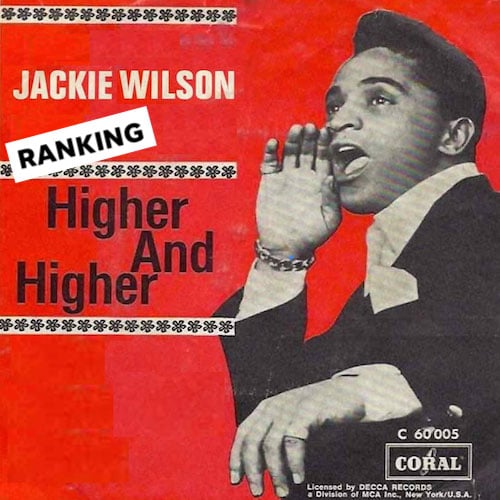
The thing is, “ranking higher” is all relative. You might be a new site or SEO beginner looking to rank higher than page six for your blog post, or you might be looking to move from the sixth spot on page one to the number one spot. So in this post, I’m going to share 17 ways to rank higher on Google , broken up into three tiers, from the more beginner strategies to the advanced.
Table of contents
How to rank high on Google
This section is mainly just the SEO basics for those of you who may not be as familiar with the world of SEO. Make sure you check off these boxes if you’re looking to rank.
1. Target reasonable keywords
First and foremost, you need to know what you want to rank for. And of course, you want to rank for terms that your ideal customers are plugging into the search box. These are keywords, and you’ll need keyword research tools to identify what’s reasonable for you to rank for.
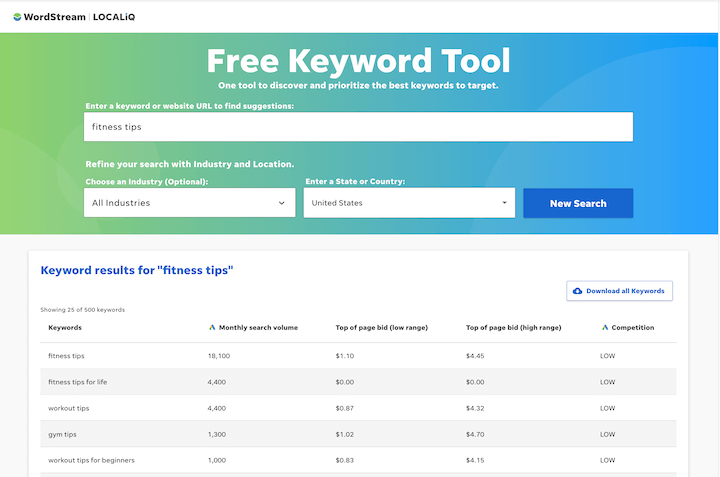
Try out WordStream’s Free Keyword Tool >>
Here are the factors involved in identifying the best keywords to target for ranking on Google:
- Volume: How many times a month the term is searched.
- Competition: How difficult it is to rank for that keyword.
- Your domain authority: Domain authority impacts how easy it will be for you to rank for keywords. If your site has been around for a while and you’ve been publishing quality content for that time, it will be easier.
- Relevance: No point in ranking for a keyword that isn’t going to bring qualified traffic to your site.
✅ Pro tip
If you’re just starting out with your SEO strategy, your best bet is to start with low volume, low competition keywords so you can gain traction, and then build up over time. What constitutes “low” will depend on your industry, but keywords in the 90-400 range might be reasonable to start.
2. Check the keyword intent
In general, there are four main types of keyword intent: informational, commercial, transactional, and navigational. Now for SEO, you’re primarily looking at informational intent keywords. But even within your informational intent keywords, you need to drill down into exactly what kind of information the person is seeking when they search that keyword.
For example, I have some screenshots I’ve accumulated of cool websites and features and was looking for a keyword to target with it. I found the keyword website ideas, saw that it had a search volume of 2900, and thought 😍 perfect. But when I Googled it, I could see that results were not for businesses looking for ideas for their websites, but rather for side hustlers seeking their next idea or beginner developers looking for their next project.
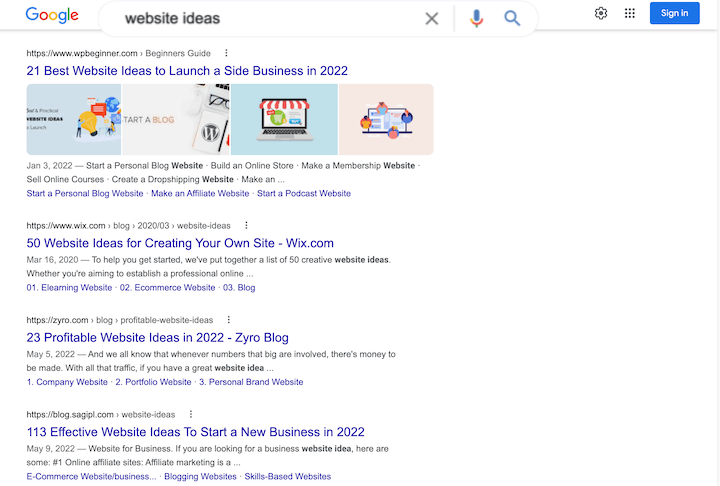
If I target that keyword with my website screenshots, it’s not going to rank. But if I target it for “website design ideas,” now that’s another story.
3. Write long-form content about it
The key to ranking high on Google? In-depth, long-form content on the keyword you’re targeting. Now this is most apparent with blog posts, but you can do this for landing pages as well.
For example, our free Website Grader landing page ranks on page one for the keyword “website grader.” On initial glance, it may look like it doesn’t have much content. But scroll down below the fold and you’ll find a treasure trove of words in the form of FAQs.
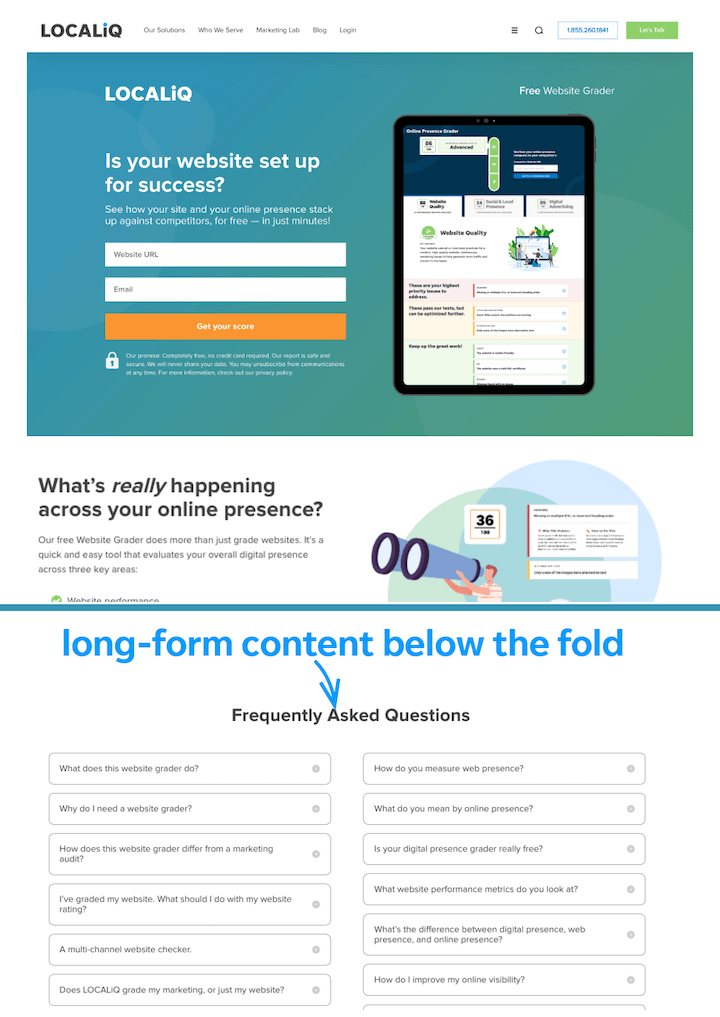
✅ Pro tip
Note that I said in-depth long-form content. Google doesn’t like thin content, so skip the fluff and go right for the peanut butter.
4. Do your on-page SEO
This is the bread and butter of ranking high on Google. Get all the deetz in my complete on-page SEO guide, but here is your short checklist:
- Keyword placement: Make sure your keyword is in your meta title, meta description, at least two H2s, in image file names, image alt text, the URL, and naturally in the body of your page.
- Internal linking: Add links to the page from at least three other pages on your site.
- External linking: Include 1-3 links on your page to relevant, trusted pages.
- Optimize meta description: Keep it 155-165 characters and tell the reader the value they’ll get by clicking on your page.
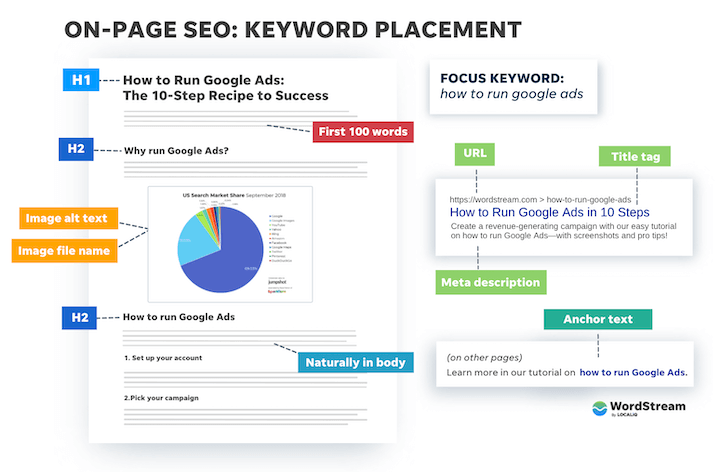
✅ Pro tip (aka plug 🔌 )
You can find out if you’re making any on-page SEO mistakes with our free Website Grader.
How to rank higher on Google
Okay so that’s how to rank high on Google. But maybe you’ve done all those things already. Maybe you’re already ranking sort of high and want to rank higher. If that is you, keep reading.
5. Target long-tail, question keywords
For the most part, keywords that hit the sweet spot in terms of volume and competition are going to be long-tail keywords, but long-tail question keywords are an added bonus because they provide opportunities to show up higher than the top results for broader, super-high-volume keywords—through the People Also Ask section.
For example “social media marketing” has a search volume of 32K (yow). WordStream is the number one result and Sprout Social is number two. But wedged in the middle of those two results is the PAA section. If a reader expands one of those questions, whichever page is answering that question now ranks higher than the #2 result in Google.
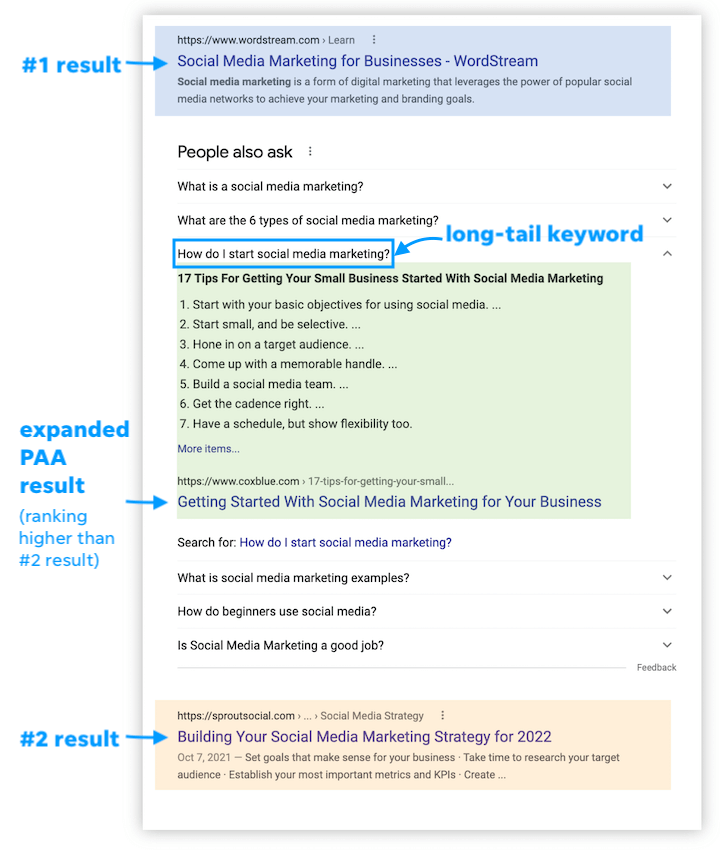
You just never know what long-tail keywords Google will pull up in PAA, giving your post an opportunity to rank higher than the #2 results for a high-volume keyword.
✅ Pro tip
Don’t target PAA questions for the purpose of ranking on Google through them. Instead, target long-tail question keywords for the primary purpose of ranking for that keyword, with the secondary goal to be some extra ranking through PAA.
6. Make your information skimmable
More and more, Google is focusing on providing answers rather than just a list of pages. Hence the term “zero-click search,” where a user can get the information they seek right in the results page without having to click into any one result. This isn’t great for those of us who want to drive website traffic, but if you can’t beat ’em (Google is like Goliath on ‘roids) join ’em, and being the source from which Google builds an answer is the next best thing—and your way to rank higher.
The best way to optimize for this is to make your content skimmable. This way, Google can extract snippets of your content to build answer-y results like with the Featured Snippet, Passage Ranking, and even meta descriptions. Here’s how:
- Use your heading tags. Every website builder/CMS allows you to do this. Don’t just create headings by increasing text size and weight; make sure they are wrapped in <h2> and <h3> tags. For example, in our How to Brand Your Business blog post, we have a clear H2 heading that reads “How to brand your business” and then each of the steps are H3s.
- Use specific headings. Unfortunately, SEO can sometimes limit your creativity. A person should be able to skim through just the headings of your article to get some immediate answers. You can see below that Google bypassed the meta description we provided for the above post and built one based on the H3s:
 Had we used more playful or colorful language here, the post may not perform as well. What do I mean? Check this chart:
Had we used more playful or colorful language here, the post may not perform as well. What do I mean? Check this chart:
| Clear heading ✅ | Unclear heading ❌ |
|---|---|
| Identify your target audience | X marks the spot |
| Create your value proposition | UVP is the MVP |
| Determine your mission | Save the whales |
| Define your brand personality | Humans only, please |
| Create brand asset | Get creating |
The easier it is for a reader to extract the information, the easier it is for Google, too. So use lists, bullets, boldface, and headings…like, a lot.
7. Make explicit statements
No, not the foul language kind. What I mean is, when you’re targeting question keywords in particular, even if it’s a multi-part answer, make sure you have an explicit statement somewhere in the post that provides a clear answer while also restating the question.
Below we see the SERP for “how long should a blog post be 2022.” Chances are, Hook Agency got the Featured Snippet position because it has a sentence that reads “The best blog length for SEO in 2022 is 1,760-2,400 words” while Wix (the number two result) answers the question but not while restating it.
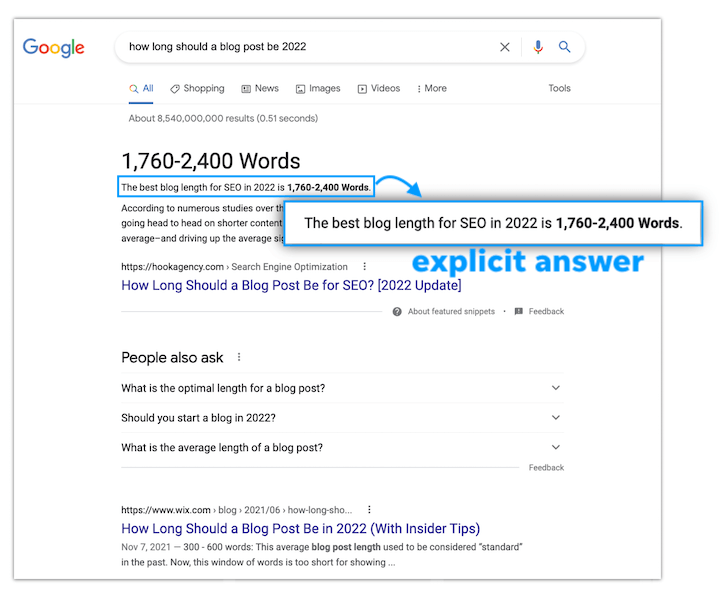
And for “how-to” keywords, you can finish off the post with a conclusion that says, “So to recap, here’s how to [do X]: then provide a list of the strategies or tips from the post. Another option would be to have an overview section at the top of the post that gives the bird’s eye view before diving deeper into each item.
8. Include meaningful visuals
Including images on your page can help it to rank higher in a few ways. First, it makes for more engaging content that keeps people on the page longer; second, regular search results are becoming more visual; and third, this gives your images a chance to also rank in image results.
But for those blog posts that you want to rank higher, stock images and empty graphics are not going to cut it. You need images that illustrate concepts, add value, and match the intent of the keyword.
For example, the SERP for “january marketing ideas” is not only very visual, but you can see that Google is giving preference to screenshots of January social media posts and event landing pages.
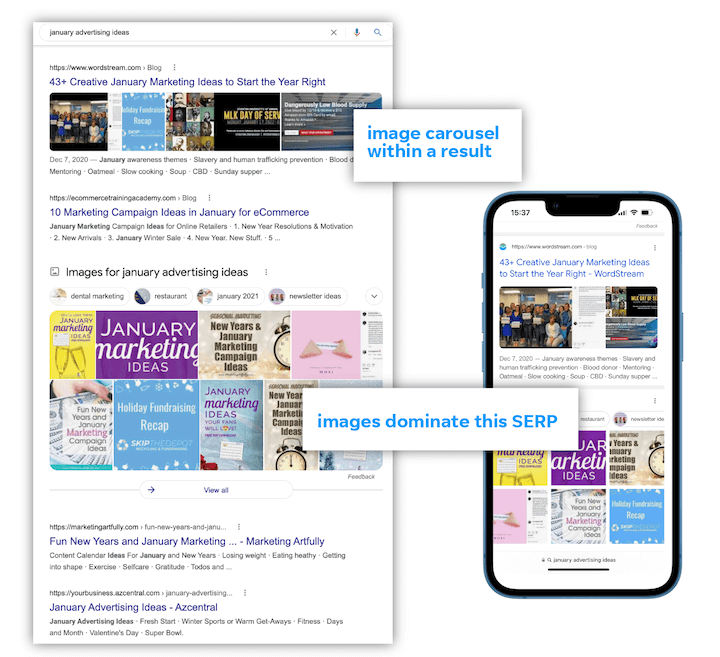
So when you’re creating content on a keyword, Google it and get a feel for not just how important visuals are, but also which visuals are showing so you can align with searchers’ expectations.
✅ Pro tip
And if, like in the example above, you can see that title card images are appearing, then make one!
Now your blog template already creates a header image (like WordStream’s does), such that it would be redundant to put it at the top of your post, move it down to the end of the post. Or, see if your SEO plugin (we use Yoast) gives you the option to upload a social image. The image won’t appear in the blog post itself, but it will still be attached to that post and indexable in search results.
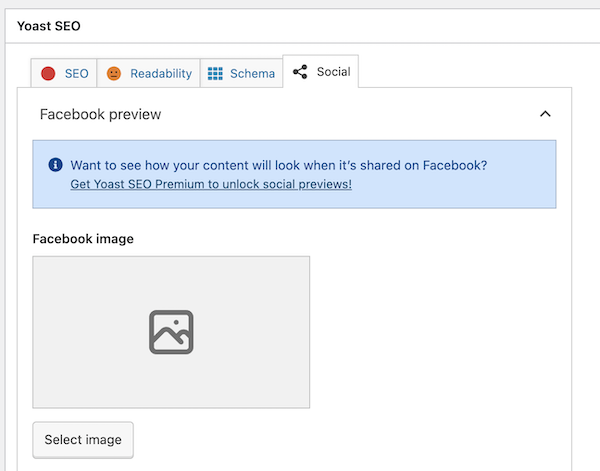
9. Have a table of contents
This is an easy element to add to your blog posts that Google seems to really like. Oftentimes, you’ll see Google add those links right to a post’s meta description.
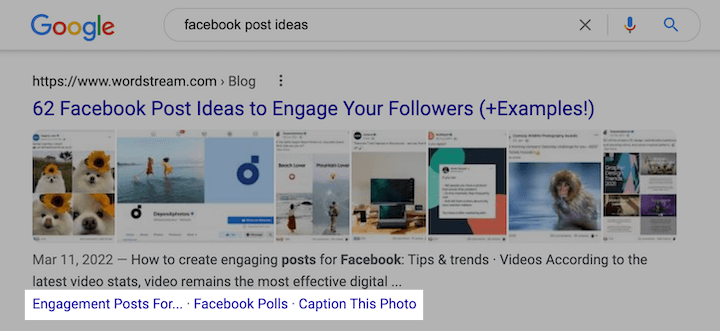
Here’s how to do it:
Go into the HTML view of your post and above each of the H2 or H3s you want to create links to, insert this:
<a id =”section-title”></a>
Keep the quotation marks, and if you use more than one word, separate them with dashes or underscores. Then at the top of your post, write out your table of contents and add a link to #section-title for each one:
For example, for this section of this post, I gave it this tag:
<a id=”higher”></a>
Then at the top, I linked “How to rank higher on Google” to #higher
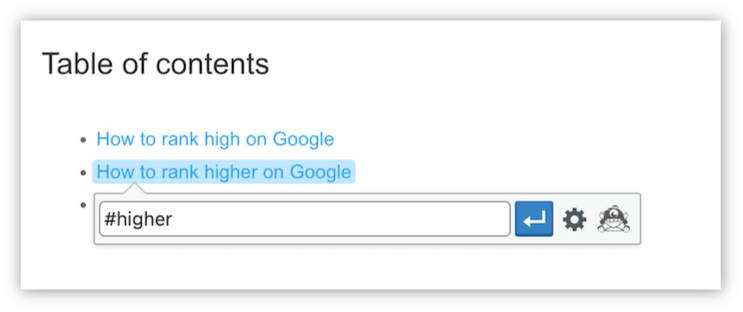
10. Borify your meta titles
Yes, you read that right. Your SEO title, or meta title, is the title that appears on the actual SERP. And similar to headings, Google doesn’t give you a whole lot of room for creativity. More often than not, a title similar to what’s already ranking on page one is the way to go.
So while you might go with something more colorful in your H1 title (the title that appears on the page itself), stick with 60 characters or less for your SEO title, front-load the keyword, and pay attention to modifiers that seem to be popular, like with the year in the title.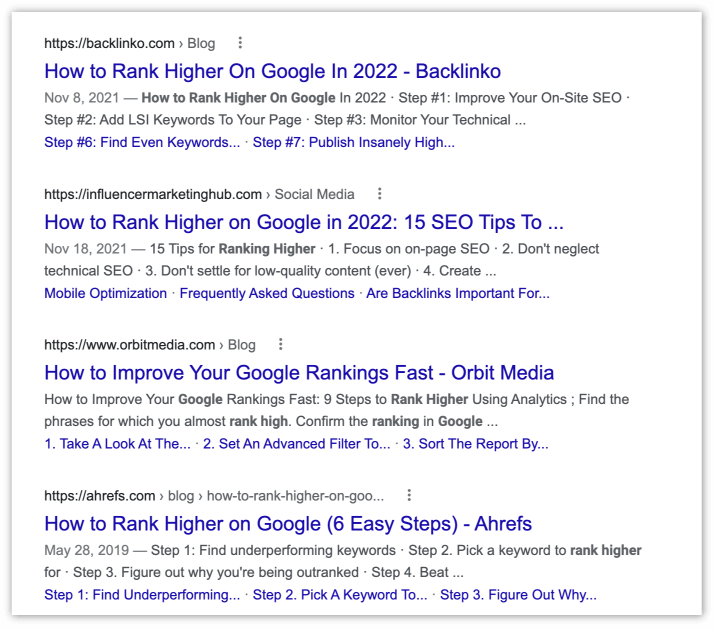
Titling this post with something more creative like “How to Rank Higher on Google: 10 Perilous Pitfalls to Avoid” probably isn’t going to help it to rank.
How to rank highest on Google
For ranking even higher, or for improving your rank for really hard keywords.
11. Get backlinks
A backlink is a link to your page from another website, and these are a heavily weighted ranking factor.
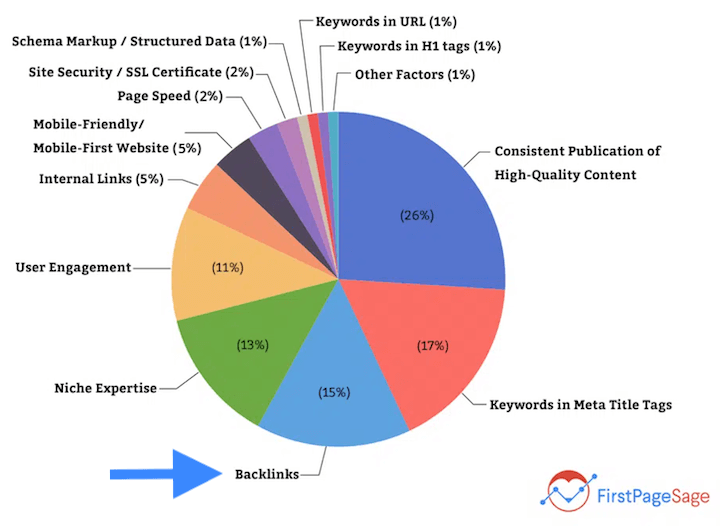
Now if you’re creating quality content and promoting it on social media, you may already be getting backlinks. But you can also be proactive with getting backlinks for specific pages. You can learn how to get backlinks here.
12. Mine your search queries
Search Console will tell you what queries are leading people to see your page in search results and which ones are leading them to click. This can help you find additional headings to add to a page as well as additional keywords to target with their own pages. If you’re already ranking accidentally for it, then you’re sure to rank when you intentionally target that keyword.
In the image below, “best advertising sentences” is a query that we’re getting impressions for. If I find that it’s a keyword, I might want to write a blog post on it or use it as a heading in an existing post.
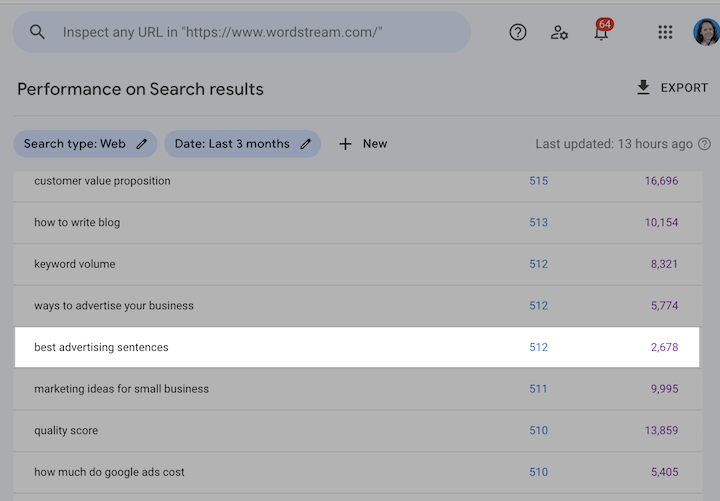
13. Target how-to and tutorial keywords with videos
Video content is showing up more and more on the SERP, and in some cases, it is the only opportunity you have to rank higher for a topic. For example, take a look at the SERP for “how to advertise on Facebook.” Between ads, People Also Ask, Facebook’s organic result, and the videos, the “top” true organic page result is literally the last result on the page.
But if you create video content on the topic, you could rank in the highest possible position for an organic result (because you’re not going to outrank Facebook).
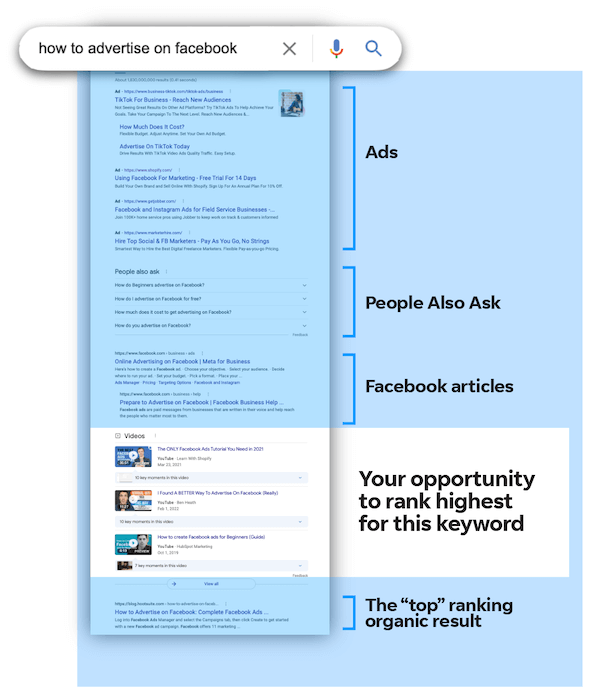
Better yet, target tutorial keywords, where video ranks even higher.
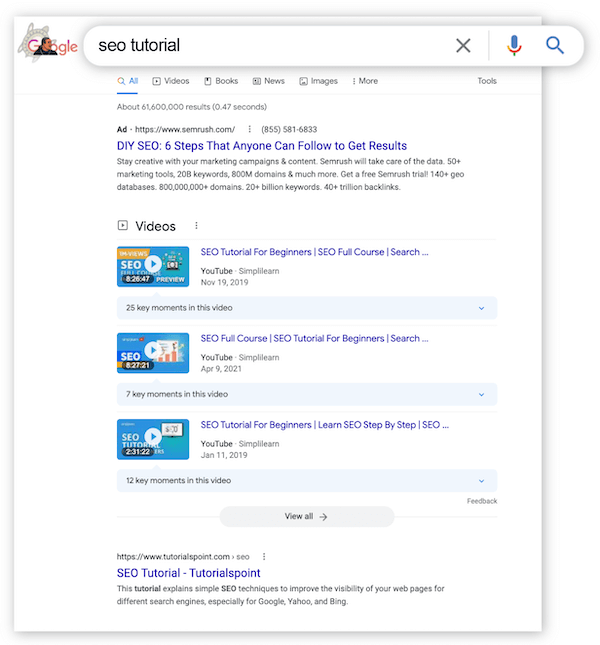
14. Target pages already ranking
It can sometimes be easier to get a post to move from position nine to position four than from, say, page nine to page four. Not only that, but the former will drive a much bigger increase in traffic than the latter. If you have a large website, use an SEO tool like Ahrefs or Semrush to filter your organic keywords by position and see if you have any pages that fit this bill, then see if you can reoptimize it.
15. Do a SERP analysis
This is another strategy where you’ll need an SEO tool. If you really really really want to rank at the top a particular keyword, you’ll want to do a SERP analysis to see exactly what it will require—and if it’s realistic. For example, if I want to rank the highest in all the land for “small business ideas,” I can see that I’m competing with HubSpot—specifically, a page that has 4,589 backlinks from 1,100 different domains on a site with a domain rating of 93.
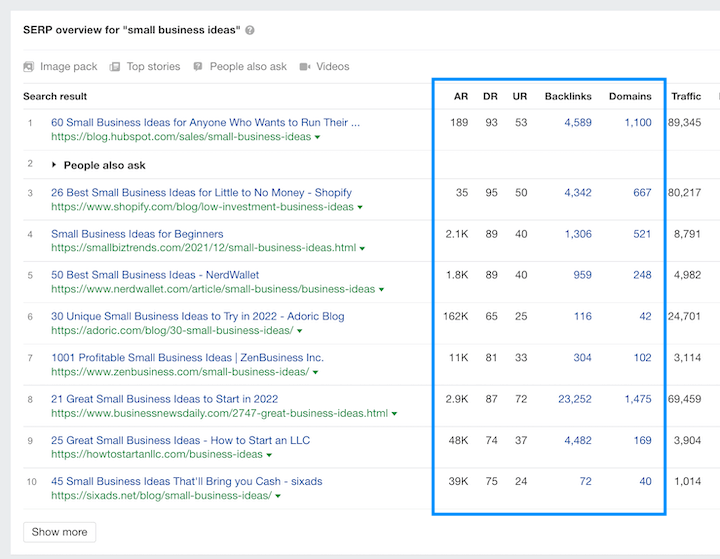
16. Add Schema markup
Schema.org markup is not a ranking factor, but it can help improve your visibility in search results and make your results more clickable. Schema markup is a way of even more specifically telling Google the types of content on your page, which can help it to appear in rich results. There are lots of different types of rich results—articles, breadcrumbs, events, FAQs, how-tos, job postings, FAQs, and more.
You can use Google’s Rich Result tester tool to see which content on your page is eligible for Schema markup.
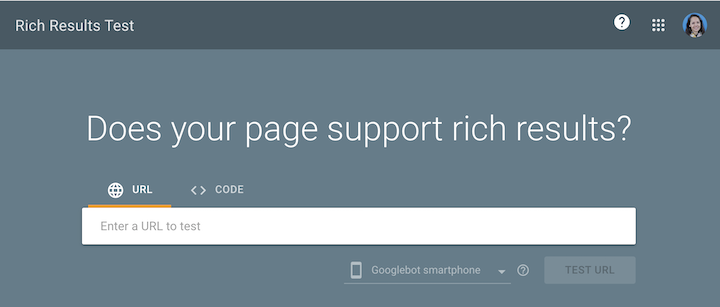
For more help on this, check out our post on Schema markup to see which ones might be most helpful for you.
17. Check your technical SEO
A lot of technical SEO is done at the site level, but there are plenty of page-level optimizations you can do in an effort to improve your ranking, like making sure your images are compressed and sized properly and that there are no indexation issues. You can check a page’s Core Web Vitals, mobile usability, and more right in Search Console.
In addition, make sure to do a manual mobile usability test—as in, don’t just use Google’s mobile-friendliness checker but actually visit the page from a mobile device to make sure the elements are rendering properly. There are some things that a code-crawler just won’t pick up on.
How to rank higher on Google: recap
And that’s it. The SERP has come a long way from the list of 10 blue links. Google is prioritizing visual, excerptable, recent content to build rich SERPS that provide immediate answers. Use these tips to rank high, higher, and highest so you can build authority in your niche and meet your website traffic and conversion goals.
In the name of explicit statements (tip #7), here is how to rank higher on Google in 2022:
-
-
- Target reasonable keywords
- Check the intent
- Write long-form content about it
- Do your on-page SEO
- Target long-tail, question keywords
- Make your information skimmable
- Make explicit statements
- Include meaningful visuals
- Have a table of contents
- Borify your meta titles
- Get backlinks
- Target your search queries
- Create video content
- Target pages already ranking
- Do a SERP analysis
- Schema markup
- Technical SEO



